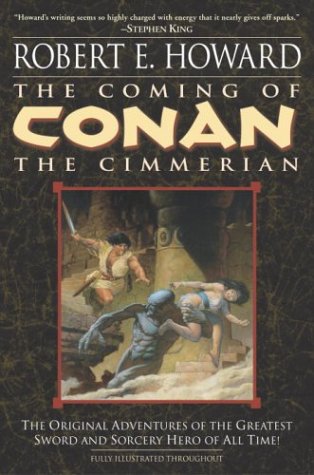New DaRK
Thoughts from the Shadows: Seismic Changes in the ...Our Favorites (and Not So Favorites) from 2008
5 Questions About: Haunted Places
Book Review: "Runner" Leaves You Breathless
"My Favorite Christmas Movie Is..." (Part 2)
"My Favorite Christmas Movie Is..." (Part 1)
Under God's Right Arm: Santa Claus is a Terrorist
Who Won the Free Copy of "Groundswell"?
12 Signs That You Might Be Santa Claus
5 Questions About: Crime Noir
Our Ongoing Features
5 Questions AboutLiterary Criticism
Fantastically Bad Cinema
Essays
Under God's Right Arm
Archive
May 2006June 2006
July 2006
August 2006
September 2006
October 2006
November 2006
December 2006
January 2007
February 2007
March 2007
April 2007
May 2007
June 2007
July 2007
August 2007
September 2007
October 2007
November 2007
December 2007
January 2008
February 2008
March 2008
April 2008
May 2008
June 2008
July 2008
August 2008
September 2008
October 2008
November 2008
December 2008
January 2009
February 2009
March 2009
Twitter
DaRK PaRTY NeTWORK
Arcanum CafeAlcoholic Poet
Baby Got Books
Beaman's World
BiblioAddict
Biblio Brat
Bill Crider's Pop Cultural Magazine
The Bleeding Tree
Blog Cabins: Movie Reviews
A Book Blogger's Diary
BookClover
Bookgasm
Bookgirl's Nightstand
Books I Done Read
Book Stack
The Book Trib
Cold Hard Football Facts
Creator of Circumstance
D-Movie Critic
The Dark Phantom Review
The Dark Sublime
Darque Reviews
Dave's Movie Reviews
Dane of War
David H. Schleicher
Devourer of Books
A Dribble of Ink
The Drunken Severed Head
Editorial Ass
Emerging Emma
Enter the Octopus
Fatally Yours
Flickhead
The Genre Files
The Gravel Pit
Gravetapping
Hello! Yoshi
HighTalk
Highway 62
The Horrors Of It All
In No Particular Order
It's A Blog Eat Blog World
Killer Kittens From Beyond the Grave
The Lair of the Evil DM
Loose Leafs From a Commonplace
Lost in the Frame
Little Black Duck
Madam Miaow Says
McSweeney's
Metaxucafe
Mike Snider on Poetry
The Millions
Moon in the Gutter
New Movie Cynics Reviews
Naked Without Books
A Newbie's Guide to Publishing
New & Improved Ed Gorman
9 to 5 Poet
No Smoking in the Skull Cave
Orpheus Sings the Guitar Electric
Polly Frost's Blog
Pop Sensation
Raincoaster
R.A. Salvatore
Reading is My Superpower
Richard Gibson
SciFi Chick
She Is Too Fond Of Books
The Short Review
Small Crimes
So Many Books
The Soulless Machine Review
Sunset Gun
That Shakesperherian Rag
Thorne's World
The Toasted Scrimitar
This Distracted Globe
Tomb It May Concern
2 Blowhards
Under God's Right Arm
A Variety of Words
The Vault of Horrr
Ward 6
When the Dead Walk the Earth
The World in the Satin Bag
Zoe's Fantasy
Zombo's Closet of Horror
Bookaholic Blogring
Power By Ringsurf
Tuesday, January 06, 2009
Comics for Literature Professors
10 Obscure Comic Book Villains and Heroes Inspired by Literature or Mythology
In Marvel Team-Up #48, Spiderman teams up with Ironman to fight the mysterious Wraith. Befuddled by who is randomly bombing targets in New York, Spiderman and Ironman join forces with Police Captain Jean DeWolff. As DeWolff discusses the case, Spiderman mutters:
“Curiouser and curiouser.”
This, of course, is a quotation from Alice uttered in the classic novel “Alice’s Adventures in Wonderland.”
It’s moments like this when fans of comic books chuckle. Comic books have always referenced classic works of fiction. In fact, many comic heroes and villains have been directly inspired by literature and mythology.
There are the obvious ones: Thor, Hercules and Conan the Barbarian come immediately to mind. Then came “The League of Extraordinary Gentlemen,” the graphic novel that combined the mythology of superhero comics with literary characters (watch a clip from the movie above). The mash-up featured Captain Nemo, Dr. Jekyll & Mr. Hyde, the Invisible Man and even Tom Sawyer.
But there are a lot of comic books characters that are lifted directly from mythology and literature that are a little less familiar. Here is DaRK PaRTY’s list of our 10 favorite comic book heroes stolen from the pages of your college literary textbook.
Icarus

Publisher: Marvel Comics
First Comic Appearance: Rom Annual #3
The Comic Character: Icarus is a human mutant with the power of flight. He does, after all, have red bird-like wings growing out of his back. He can fly and has an extensive regenerative powers to heal from normally fatal injuries.
Literary Inspiration: The Greek myth of Icarus is that he the son of Daedalus. Father and son try to escape from exile from the island of Crete by fashioning bird wings made of feathers and wax. Daedalus warns Icarus not to fly too close to the sun or the wax would melt his wings. Caught in the exhilaration of flight, Icarus ignores his father’s warning and plummets to his death.
Literary Origin: From the poem in Pseudo-Apollodorus, but made popular by Ovid in the 15th century.
 Tar Baby
Tar BabyPublisher: Marvel Comics
First Comic Appearance: Power Pack vol. 1 #12 (1985)
The Comic Character: Tar Baby is a human mutant that could secrete a tar-like substance from his skin. This allowed Tar Baby the ability to stack to anything that came in contact with him. The character wore raggedy purple trousers with patches and a rope belt and had black skin.
Literary Inspiration: The story of Tar Baby comes from African-American folklore. The tale has Br’er Fox and Br’er Bear build a doll out of tar (dressed in old rags) to capture Br’er Rabbit. When Br’er Rabbit talks to Tar Baby and it doesn’t answer he gets angry and starts to hit and kick it – only to become enmeshed in the sticky tar. He is caught and pleads with Br’er Fox not to be thrown in the briar patch. So Br’er Fox does and, of course, Br’er Rabbit is at home in the thicket and escapes.
Literary Origin: African-American folklore. First published in “Harper’s Weekly” by Robert Roosevelt. But it was Joel Chandler Harris’ Uncle Remus stories published in 1904 that made Tar Baby famous.
Mad Hatter
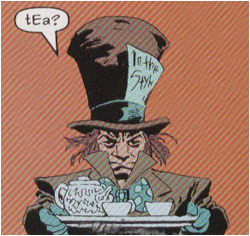
Publisher: DC Comics
First Comic Appearance: Batman #49 (1948)
The Comic Character: The Mad Hatter is a paranoid schizophrenic obsessed with hats of all sizes. He’s also a genius fond of quoting from Lewis Carroll. He’s a criminal mastermind and a nemesis of Batman. While he has no superpowers, the Mad Hatter is a technologist and scientist who specializes in mind control.
Literary Inspiration: The Hatter from Lewis Carroll’s “Alice’s Adventures in Wonderland” (commonly called the Mad Hatter. However, he is never referred by this name in Carroll’s Alice books. He appears with the March Hare at a tea party – which never ends. In “Alice’s Adventures in Wonderland,” the Hatter asks the riddle “Why is a raven like a writing desk?” The Hatter doesn’t have an answer and the riddle remains just that: a riddle.
Literary Origin: “Alice’s Adventures in Wonderland” for published in 1865.
 Valkyrie
ValkyriePublisher: Marvel Comics
First Comic Appearance: Avengers vol. 1 #83 (1970)
The Comic Character: The Valkyrie is a member of the Defenders. She has superhuman strength, slowed aging, hundreds of years of combat experience (especially with a sword) and the ability to speak with the spirits of the dead. She can also see death coming when a person begins to glow.
Literary Inspiration: The Valkyries in Norse mythology are winged female deities who carry off the spirits of slain warriors off the battlefield to Valhalla, the Norse underworld.
Literary Origin: Norse and Germanic mythology. First appearance is the poem Voluspa.
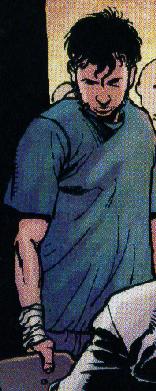 Fagin
FaginPublisher: Marvel Comics
First Comic Appearance: The Brotherhood #1 (2001)
The Comic Character: Fagin is a human mutant with the ability to transform into a purple humanoid with spikes and enhanced strength. He resides (surprise!) in London and lists his occupation as terrorist. He recruits another young mutant to join the terrorist organization The Brotherhood by sweet talking him.
Literary Inspiration: Charles Dickens villain Fagin – a “receiver of stolen goods” and a “merry old gentleman” who is described as disgusting to look at. He is the leader of a group of children he recruited to pick pockets and steal goods. He sweet talks the children while he collects their stolen goods and hordes the profits for himself.
Literary Origin: “Oliver Twist” (1838)
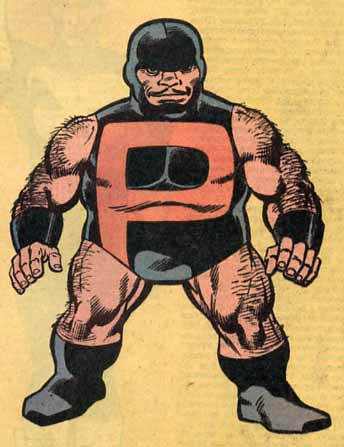 Puck
PuckPublisher: Marvel Comics
First Comic Appearance: Alpha Flight #1 (1983)
The Comic Character: A dwarf with super strength, stamina, and speed. He was a member of the superhero team Alpha Flight. He was born Eugene Milton Judd in Canada and was a soldier, bouncer and secret agent before joining Alpha Flight. Marvel later created a second “Puck” who was the daughter of Eugene, but the comic did poorly.
Literary Inspiration: Puck is a fairy – really a mischievous faun – who also goes by the name of Robin Goodfellow. Puck is Oberon’s (the fairy king’s) servant and causes all kinds of problems when he gives a love potion to the wrong people.
Literary Origin: “A Midsummer Night’s Dream” by William Shakespeare
Morlocks

Publisher: Marvel Comics
First Comic Appearance: Uncanny X-Men #169 (1983)
The Comic Characters: The Morlocks are a group of mutants. They are considered “extreme” mutants that are unable to pass as humans due to their appearance. They lived in a series of underground tunnels beneath New York City. The members include mutants like Skid, who can create a force field around her; Feral, a cat-like human with fangs and claws; and the deformed Caliban, who can sense and track other mutants.
Literary Inspiration: A species of humanoid creatures from A.D. 802,701 who live underground and are described as resembling ants (although they have fur). They hunt in groups at night because they are extremely sensitive to daylight. They feed on a human like species known as Eloi (whom they reference to as “cattle”).
Literary Origin: “The Time Machine” by H.G. Wells (1895)
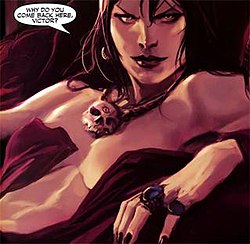 Morgane le Fay
Morgane le FayPublisher: DC Comics
First Comic Appearance: The Demon (Vol. 1) #1 (1983)
The Comic Character: She is a sorceress skilled in black magic. She has the ability to travel to other dimensions. She was an enemy of Wonder Woman. In order to keep being immortal, she needs to steal the life force from other living beings. She wears golden armor to hide her withered and aging body.
Literary Inspiration: Morgan Le Fay was a powerful sorceress and the enemy of King Arthur in medieval England. She is also King Arthur’s half-sister. Originally, she may have been a fairy before being portrayed as a human woman.
Literary Origin: She appears in Arthurian legends in Welsh mythology.
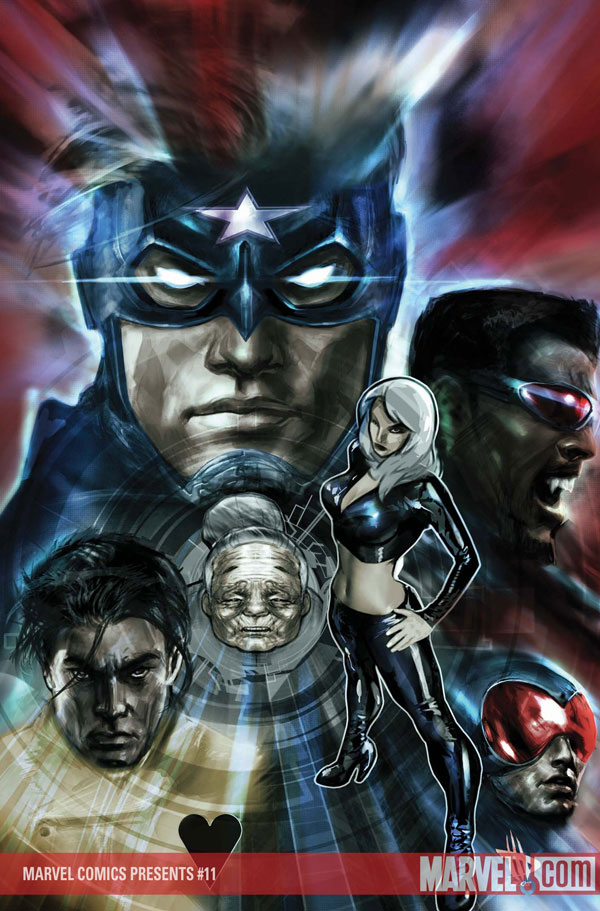 Horsemen of the Apocalypse
Horsemen of the ApocalypsePublisher: Marvel Comics
First Comic Appearance: X-Factor #15 (1987)
The Comic Characters: A team of super villains called Death, Famine, Pestilence, and War. Many different mutants and superheroes have filled the various roles of the Apoclaypse including the Hulk (War), Gambit (Death), Polaris (Pestilence), and Sunfire (Famine).
Literary Inspiration: The four horsemen of the apocalypse appear in the Book of Revelations. Only Death is given a name, but the other three are described and known as Strife, War, and Famine. Strife rides a white horse and carries a bow. War rides a red horse and holds a sword. Famine rides a black horse and carries a weight balance. Death rides a pale green horse and is followed by Hades (or Pluto).
Literary Origin: The Bible
 Solomon Grundy
Solomon GrundyPublisher: DC Comics
First Comic Appearance: All-American Comics #61 (1944)
The Comic Character: A monstrous, simple-minded zombie made up up of swamp matter who is an enemy of Green Lantern and Batman. He has super strength and endurance and can return from the dead.
Literary Inspiration: A nursery rhyme character that was a riddle. Solomon Grundy lives his entire life in a week. The poem starts: “Solomon Grundy/ Born on a Monday” and ends with “Buried on Sunday/ That was the end of/ Solomon Grundy.” The name Solomon Grundy is supposedly from the English food Salmagundi (a salad made from cooked meats, seafood, fruit, and nuts).
Literary Origin: A 19th century nursery rhyme that was made mainstream by James Orchard Halliwell-Phillipps in 1842.
Labels: comics, literature, superheroes
 StumbleUpon |
StumbleUpon |
 del.icio.us |
del.icio.us |
 Technorati |
Technorati |
1 Comments:
 Viagra Sex said...
Viagra Sex said...
Yeah actually all characters in movies or comics are based in many ancient stuff... so there's nothing new to show to the public.

This work is licensed under a Creative Commons Attribution-No Derivative Works 3.0 License.
The Template is generated via PsycHo and is Licensed.

